 The Pacific Northwest is blessed with considerable coastline, both on the open Pacific and the shores of the Salish Sea. While beautiful, the coastline might not be the first place a gardener would go for inspiration. “The Northwest Coastal Explorer” by Robert Steelquist may change that attitude.
The Pacific Northwest is blessed with considerable coastline, both on the open Pacific and the shores of the Salish Sea. While beautiful, the coastline might not be the first place a gardener would go for inspiration. “The Northwest Coastal Explorer” by Robert Steelquist may change that attitude.
The author engagingly introduces plants ranging from seaweed to conifers, from underwater to the coastal forests and riverbanks. He includes kelp, eelgrass, and pickleweed – all plants that have adapted to a very specialized environment.
Steelquist understands that these plants, while rather odd-looking and perhaps not as appealing as the animal life, have an equally important role in the coastal ecosystems. If you see on the water surface the floating stems and bulbs of bull kelp (Nereocystis luetkeana), then “…what’s underneath is as lush as any rain forest.”
Excerpted from the Fall 2017 Arboretum Bulletin.
 Phyllis Reynolds co-wrote “Trees of Greater Portland”, published in 1993. Twenty years later, she has written the second edition of this worthy guide to urban trees, narrowing her definition of “Greater Portland” so that most of the subjects now included are within the city limits. The Miller Library has both editions.
Phyllis Reynolds co-wrote “Trees of Greater Portland”, published in 1993. Twenty years later, she has written the second edition of this worthy guide to urban trees, narrowing her definition of “Greater Portland” so that most of the subjects now included are within the city limits. The Miller Library has both editions.
She revisited and re-photographed all the trees from the first edition, sadly removing the ones that are gone, but adding some that are new. Most interesting is comparing the photographs of the same tree in the two editions after twenty years more growth. One of the most remarkable is a Malus x domestica ‘Yellow Bellflower’, a winter apple with pale yellow fruit. Thought to be planted in 1848, it still blooms and bears fruit.
For the Portland resident or visitor, the nine tree tours at the end of each book will be of the most interest. These are in neighborhoods especially rich with notable trees, many profiled earlier in the book. To sharpen your recognition skills, the author only identifies one example of each species on the walk, as she explains, “This should be a learning experience.”
Excerpted from the Fall 2017 Arboretum Bulletin.
George Schenk is best known for his classic The Complete Shade Gardener (1984 and 1991), a bible for me in my early days of gardening in my shady backyard. What I learned recently is that his writing career began much earlier with the 1964 Sunset publication How to Plan, Establish, and Maintain Rock Gardens.
Early Sunset books like this are much meatier than recent ones, and the writing is pure Schenk, a witty combination of observation and intuitive insight, all enhanced by the photographs of Don Normark. Best of all, the author draws on his Seattle area roots for many of his examples.
Schenk includes some unexpected discussion topics for this genre, including desert, woodland, and bog gardens. He closes with what he calls the plant biographies “…of the best, the strangest, and the most charming plants for American rock gardens.”
Published in Garden Notes: Northwest Horticultural Society, Fall 2017
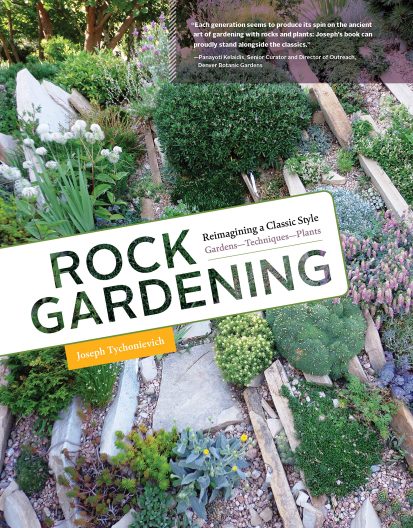 The Rock Gardening section of the Miller Library is quite extensive. It contains some of the library’s oldest tomes rich in detail, but the scarcity of newer titles might suggest this form of gardening has gone out of fashion.
The Rock Gardening section of the Miller Library is quite extensive. It contains some of the library’s oldest tomes rich in detail, but the scarcity of newer titles might suggest this form of gardening has gone out of fashion.
However, for those interested in creating gardens that are tolerant of our droughty summers, rock gardening is an excellent style to consider. To help spur your interest, I recommend Rock Gardening: Reimagining a Classic Style.
Author Joseph Tychonievich has an infectious, enthusiastic writing style and easily brings new life to an old gardening subject. His research finds rock gardens evolving with expanding plant palettes. They are set in both sun and shade, and can be compatible with nearby, more lushly planted areas. Moreover, they don’t necessarily include rocks! “This book aims to be an introduction into that wide world of the rock garden in all its diverse modern incarnations.”
He uses many examples from throughout the United States and the United Kingdom, and includes two gardens in Medford, Oregon. His list of recommended plants is restrained but goes well beyond the traditional alpines, and encourages experimentation.
Published in Garden Notes: Northwest Horticultural Society, Fall 2017
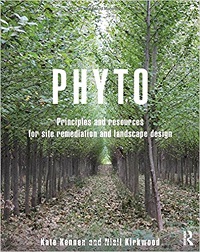
What is phytotechnology? Kate Kennen and Niall Kirkwood define it in part as “the use of vegetation to remediate, contain or prevent contaminants in soils, sediments and groundwater.”
How is this done? Kennen and Kirkwood use their new book, Phyto: Principles and Resources for Site Remediation and Landscape Design, to answer this question. They specifically target landscape architects, urban planners, and others who are interested in applying the lessons of the relatively new field of using plants as problem solvers in design, construction, and maintenance.
This book is superbly organized and very detailed, but the reader is not expected to have a deep understanding of the science or engineering of phytotechnology. Instead, the emphasis is on results, particularly on properties that have a significant history of degradation and are in close proximity to urban development, including active industrial, commercial, and residential neighborhoods.
There are many case studies. The examples are typical to any city, but some of the at-risk properties are surprising, and include community gardens and cemeteries – humans have a significant impact on almost any development. Once the hazards of a site are identified, solutions are suggested and clearly illustrated. This excellent book concludes with guides to additional resources and an extensive bibliography.
Published in the July 2017 Leaflet for Scholars Volume 4, Issue 7

After you read this book to a child, go for a walk in the urban landscape and ask, “Where could birds roost?” Children will be eager to look up and around for the kinds of nesting spots described and pictured in Urban Roosts. Barbara Bash has chosen a dozen species and multiple city sites to tell how pigeons, finches, crows, and falcons have adapted to the city, finding tiny but sheltering niches to call home. The colors are soft, mainly pastels, and the bird sketches clearly identifiable. Although this is aimed at the picture book set, adults may find themselves searching for city nests, too, after sharing this book with a child.
Published in the July 2017 Leaflet Volume 4, Issue 7.
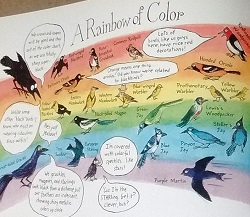
This looks like a comic book with bird commentary, but it packs a barrelful of information for budding bird watchers. Annette LeBlanc Cate lures young readers with wisecracking robins and sparrows (and people). In the page on A Rainbow of Color, for instance, the European starling explains, “I’m covered with colorful speckles . . . like stars. ‘Cuz I’m a STARling. Get it?” Her goal is to encourage young readers to watch carefully, to see details, and to place birds in context. She also urges sketching birds as a way to increase focus and create a personal record. Cate begins the book by saying you don’t really need equipment to begin bird watching, and if you want binoculars, they needn’t be costly. By mid-book, she suggests it’s time for a field guide, and she lists several in the bibliography. So she moves the reader from a boy saying that bird watching “Looks kinda boring” to several pages on rather scientific bird classification at the end. The reader (of any age) who follows the book all the way through will have a solid start on the enjoyment of birding. And if you never go beyond reading the book, you will still have had a good time.
Published in the July 2017 Leaflet Volume 4, Issue 7.
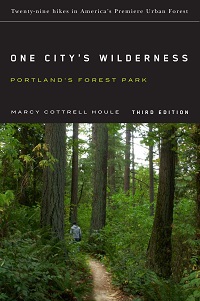
Urban forests are rare treasures, and one of the largest in the country is located nearby in Portland, Oregon. Forest Park encompasses over 5,000 acres of second growth forest left mostly to develop naturally since the park was established in 1948.
The third edition (2010) of One City’s Wilderness by Marcy Cottrell Houle, now available in the Miller Library, is an excellent introduction to the flora and fauna of Forest Park, along with its history, geology, and topography. Summaries of these topics form the introductory chapters, with highlights found in the extensive descriptions of 29 recommended hikes that follow.
The maps, elevation graphs, and finding aids for these hikes are top-notch. Even from my home in Seattle some 200 miles away, I enjoyed the narrative of these forest adventures located only a few minutes from downtown Portland. As author Houle concludes, “Forest Park’s pristine and natural features are what set it apart from all other city parks in the nation. No other urban park in the United States offers anything comparable in quantity or quality.”
Forest Park would be an excellent destination for your summer travels. I recommend reading this book to get the most enjoyment from your visit.
Published in the June 2017 Leaflet for Scholars Volume 4, Issue 6.
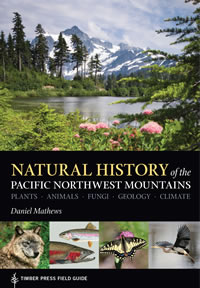
I find field guides fascinating and always enjoy reading new ones. “Natural History of the Pacific Northwest Mountains” by Daniel Mathews is something of a hybrid between a traditional field guide, and a collection of natural history essays. There are enough photos and text descriptions to help you recognize the most common plants, animals, bugs, and even the rocks of our mountains.
While field guides with detailed keys or multiple photographs for each species might be better for fine-tuning your plant identification, this is handy if your specimen is occupied by some winged creature – just flip to another part of the book to identify it, too. Interspersed are anecdotes and observations of the more noteworthy genera that make this a delightful book to read from cover to cover.
This isn’t exactly a new field guide. Mathews describes it as “essentially an expanded and updated third edition of “Cascade-Olympic Natural History,” the second edition under that earlier title was published in 1999. However, it is new to me and I found it quite interesting. Unlike some other all-in-one field guides, plants are not short-changed and – if you include mosses, fungi, and lichens – comprise half of the book.
The essays on the trees, shrubs, and wildflowers are delightful. For example, the glacier (Erythronium grandiflorum) and avalanche (E. montanum) lilies “…seem ideal vehicles for those anthropomorphic virtues we love to foist on mountain wildflowers—innocence, bravery, simplicity, perseverance, patient suffering, and so on. They toil not, neither do they spin, and they don’t taste half bad either.”
Excerpted from the Summer 2017 Arboretum Bulletin.
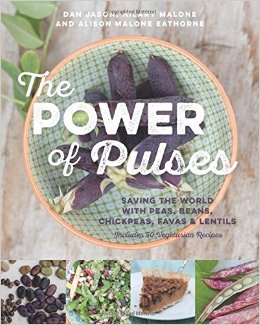 When I first heard the title, “The Power of Pulses,” I was perplexed as to the subject of the book. The word pulse has many meanings! This is a book better defined by its sub-title: “Saving the World with Peas, Beans, Chickpeas, Favas & Lentils.”
When I first heard the title, “The Power of Pulses,” I was perplexed as to the subject of the book. The word pulse has many meanings! This is a book better defined by its sub-title: “Saving the World with Peas, Beans, Chickpeas, Favas & Lentils.”
To be more precise, a pulse is a legume harvested mainly for the dry seed. The primary author, Dan Jason of Salt Spring Island, British Columbia, has chosen to concentrate on the five that are the easiest to grow in the temperate climates of Canada and the northern United States.
The sub-title also hints at Jason’s proselytizing zeal for growing these plants. Of course, he also sells them through his company, Salt Spring Seeds. But never mind this possible conflict; this is an excellent introduction to these easy-to-grow, highly nutritious, and earth-friendly foods that require little water and no fertilizer. While generally very positive, the author is not afraid to express his disgust on certain matters, noting “…the common white navy bean has practically no taste and a texture that leaves everything to be desired.”
The last part of the book is devoted to 50 vegetarian recipes using pulses and contributed by the co-authors, sisters Hilary Malone and Alison Malone Eathorne of Nanaimo, British Columbia. These tasty sounding treats take you well beyond traditional soups and stews to everything from breakfast to desserts.
Excerpted from the Summer 2017 Arboretum Bulletin.
 The Pacific Northwest is blessed with considerable coastline, both on the open Pacific and the shores of the Salish Sea. While beautiful, the coastline might not be the first place a gardener would go for inspiration. “The Northwest Coastal Explorer” by Robert Steelquist may change that attitude.
The Pacific Northwest is blessed with considerable coastline, both on the open Pacific and the shores of the Salish Sea. While beautiful, the coastline might not be the first place a gardener would go for inspiration. “The Northwest Coastal Explorer” by Robert Steelquist may change that attitude. The Rock Gardening section of the Miller Library is quite extensive. It contains some of the library’s oldest tomes rich in detail, but the scarcity of newer titles might suggest this form of gardening has gone out of fashion.
The Rock Gardening section of the Miller Library is quite extensive. It contains some of the library’s oldest tomes rich in detail, but the scarcity of newer titles might suggest this form of gardening has gone out of fashion.




 When I first heard the title, “The Power of Pulses,” I was perplexed as to the subject of the book. The word pulse has many meanings! This is a book better defined by its sub-title: “Saving the World with Peas, Beans, Chickpeas, Favas & Lentils.”
When I first heard the title, “The Power of Pulses,” I was perplexed as to the subject of the book. The word pulse has many meanings! This is a book better defined by its sub-title: “Saving the World with Peas, Beans, Chickpeas, Favas & Lentils.”